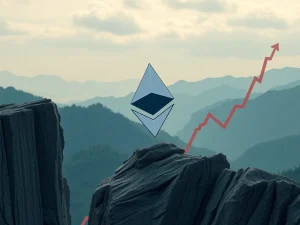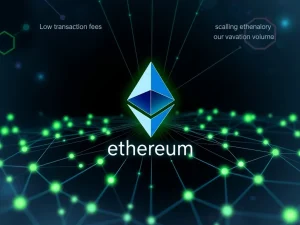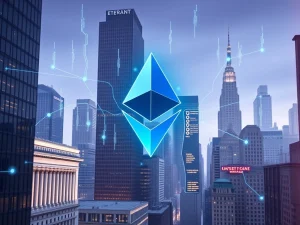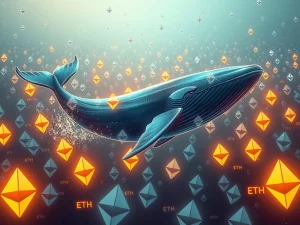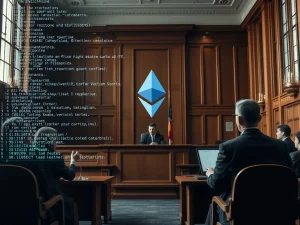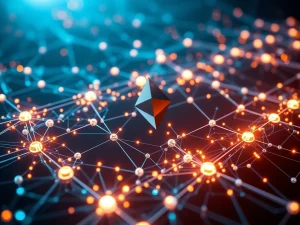Ethereum’s Pivotal Fusaka Upgrade: Unlocking Enhanced Scalability in November 2025

The cryptocurrency world constantly evolves. Ethereum, a leading blockchain, prepares for its next major leap. The Ethereum Fusaka upgrade, scheduled for November 2025, promises significant advancements. This crucial hard fork will enhance the network’s core capabilities. It focuses on scalability, node resilience, and overall efficiency. Developers aim to refine the blockchain’s engine, not its user-facing features. This article delves into what makes Fusaka a pivotal moment for Ethereum.
Understanding the Ethereum Fusaka Upgrade
Ethereum’s upcoming Fusaka hard fork is slated for early November 2025. This event sets the stage for one of the most consequential Ethereum network upgrades in years. Unlike its predecessor, Pectra (May 2025), Fusaka operates primarily behind the scenes. Pectra delivered visible changes like account abstraction and higher staking limits. Fusaka, however, bundles 11 Ethereum Improvement Proposals (EIPs). These EIPs focus on fundamental aspects: scalability, node resilience, and efficiency. They leave existing smart contracts untouched. Therefore, DApps and user interfaces will remain fully compatible.
A devnet launched in July 2025. This provided developers with a crucial testing ground. Subsequently, a round of public Ethereum testnets in September and October will stress-test the changes. These rigorous tests precede mainnet activation. Developers aim to ship the upgrade ahead of the Devconnect conference in Buenos Aires. This aligns with Ethereum’s accelerated six-month upgrade cadence. It also highlights a growing focus on core performance. Fusaka joins a lineage of about a dozen execution-layer hard forks. These range from Frontier in 2015 through Pectra in 2025. Each upgrade iteratively strengthens the network.
What is the ETH Hard Fork Fusaka?
The Fusaka hard fork represents the next major Ethereum development milestone. It lands only six months after Pectra. As part of the chain’s Ethereum roadmap 2025, Fusaka emphasizes critical updates. It focuses on Ethereum scalability and node health. User-facing features are not its primary goal. The timeline for this upgrade is notably tight. Devnet-3 went live in July 2025. Public Ethereum testnets followed in September. The mainnet fork is set for November 5, 2025. This activation coordinates to hit a predefined block height.
The chosen date is strategic. It aligns with Ethereum community updates around Devconnect. By focusing on protocol refinement, this crypto hard fork lays essential groundwork. It prepares for future proposals, such as block-time reduction. Meanwhile, it maintains Ethereum’s reputation for steady, iterative progress. This approach ensures stability while pushing the boundaries of what the network can achieve. Furthermore, the upgrade demonstrates a commitment to long-term sustainability and performance.
Key Improvements: Boosting Ethereum Scalability and Efficiency
The Ethereum Fusaka upgrade centers on tuning Ethereum’s core engine. The November 2025 Ethereum hard fork bundles 11 infrastructure-level EIPs. These EIPs refine scalability, improve efficiency, and harden the network. Importantly, they achieve this without breaking existing contracts. Here is a breakdown of what these significant proposals aim to deliver:
- EIP-7594 – PeerDAS: This represents a major step in Ethereum scalability updates. It introduces peer data availability sampling. Nodes will no longer need to download full data blobs. This lightens the load significantly. It also boosts rollup performance.
- EIP-7825 – Spam Resistance Checks: Often cited in Ethereum news, this EIP prevents malicious transaction spam. It helps nodes stay stable even under high demand.
- EIP-7823 – MODEXP Parameter Limit: This caps modular exponentiation input sizes. It strengthens Ethereum’s resilience to denial-of-service attacks.
- EIP-7883 – MODEXP Gas Cost Adjustment: This adjusts gas pricing for heavy cryptographic operations. It serves as an important Ethereum efficiency improvement.
- EIP-7892 – Blob Parameter-Only Forks: This creates a framework for lightweight blob-related tweaks. These will come in future forks. It aligns with the broader Ethereum 2025 roadmap.
- EIP-7917 – Deterministic Proposer Lookahead: This precomputes block proposers. It streamlines validation, benefiting rollups and staking operations. Many ETH staking updates highlight this EIP.
- EIP-7918 – Blob Base Fee Bound: This links blob fees to execution costs. It ensures fairer and more predictable pricing.
- EIP-7934 – RLP Execution Block Size Limit: This puts an upper cap on encoded block sizes. It limits bloat and supports Ethereum scalability. Compatibility remains intact.
- EIP-7935 – Default Block Gas Limit: This lays out the Ethereum gas limit increase 2025. It starts around 45 million units. It scales toward 150 million units. This enables more transactions per block.
- EIP-7939 – CLZ Opcode: This adds a “count leading zeros” instruction. It is useful for cryptography, compression, and bit-level optimizations.
- EIP-7951 – secp256r1 Precompile: This brings native support for the P-256 elliptic curve. It bridges Ethereum closer to Web2 security standards and wallets.
By pulling heavier proposals like EIP-7907 and the EVM Object Format from this fork, developers kept Fusaka focused and testable. The result is set to be a stable crypto hard fork. It delivers critical back-end upgrades without disrupting DApps. This represents the kind of incremental refinement for which Vitalik Buterin’s Ethereum is known.
The Ambitious Ethereum Roadmap 2025 and Beyond
The path to Fusaka’s activation is aggressive yet deliberate. It reflects Ethereum’s new semiannual rhythm of upcoming network upgrades. Devnet-3 spun up on July 23, 2025. This gave developers a contained space to hammer on EIPs. They stress-tested scalability tweaks. After that, attention shifted to September’s two public Ethereum testnets. These were short, intense cycles. Client teams, node operators, and DApp developers could uncover bugs. This happened before any issues hit the mainnet. A firm EIP freeze on August 1 locked the scope. This allowed roughly six weeks for interoperability checks, bug bounties, and release polishing. Mainnet activation is slated for November 5-12. It is pinned to a block height that lands just before Devconnect.
Here, one can note how the Ethereum roadmap 2025 blends discipline with ambition. Each blockchain upgrade gets tested, fixed, and launched on schedule. Developers quietly prepare the next wave. Ethereum’s theoretical TPS ceiling remains modest. Based on current settings (approximately 36 million gas limit, 12-second block time), maximum throughput tops out at around 142 transactions per second. This is well below payment networks like Visa. Fusaka’s tweaks to gas limits and block-time proposals could help push that higher. This iterative improvement is key to Ethereum’s long-term viability.
Ethereum Gas Limit Increases and Future Proposals
Fusaka is partly a response to Ethereum community updates and conference deadlines. With Devconnect Buenos Aires on the horizon (November 17-22, 2025), core contributors have been blunt about the pressure to ship. As protocol-support member Nixo warned, “If we want to ship by Devconnect, we need our timeline TIGHT.” Even as Fusaka nears release, attention shifts toward Ethereum development for 2026’s Glamsterdam fork. That upgrade could bring bold changes. These include an Ethereum block time reduction proposal (EIP-7782) to six seconds. This would effectively double throughput. It would make the network feel snappier for wallets and Layer 2s.
Other conversations involve further Ethereum gas limit adjustments. ETH staking updates are also on the agenda. Support for the expanding DeFi load remains a priority. Decisions will crystallize at the August 1 AllCoreDevs – Execution meeting. This proves that Ethereum’s culture of continuous, transparent evolution is very much alive. The community’s active participation ensures the network’s resilience and adaptability. These discussions shape the future of decentralized finance and applications.
Impact for Users and Developers from the ETH Hard Fork
For developers, Fusaka acts as a quiet powerhouse. Higher gas ceilings represent a significant improvement. With an initial move toward 45 million and scaling up, these translate to more transactions per block. Meanwhile, PeerDAS relieves node workloads. It also improves rollup performance. Crucially, none of these Ethereum scalability updates break contracts or interfaces. DApps and clients remain fully compatible. This offers important reassurance for builders. They can continue innovating without fear of disruption.
For everyday users, the Ethereum efficiency improvements will not scream for attention. However, they will notice steadier gas fees. Smoother transaction flow during high-traffic moments will also be apparent. Yet, trade-offs always lurk. A bigger gas limit raises storage and bandwidth demands. This could strain smaller validators. It might nudge the network toward heavier reliance on industrial-scale operators. Still, Fusaka’s measured approach embodies the ethos of Vitalik Buterin’s Ethereum. It refines the plumbing without overhauling the entire house. The network iterates, improves, and makes space for the next leap. It balances performance with decentralization, ensuring a robust future for all participants.

